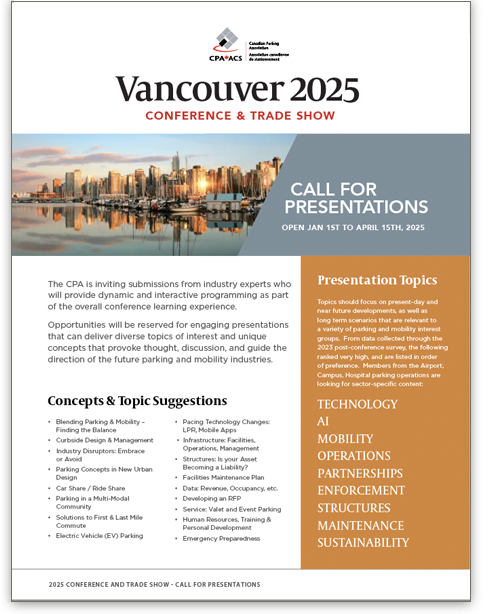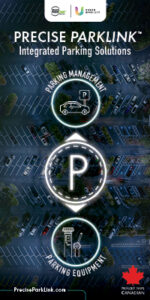By Ralph Bond
It seems that almost every week there is a news article about how the fast approaching world of autonomous vehicles (AV’s) will change the way we travel, impact on transportation related infrastructure – especially parking, and influence planning and design for urban real estate development. There is a wide divergence of opinion on when and how the impacts might occur and many unsubstantiated pronouncements. Nevertheless, an increasing number of developers as well as public sector agencies and municipalities are becoming concerned about the potential impacts and the risks associated with building new infrastructure that may not be suitable for the future.
The increased use of ride hailing services like Uber and Lyft is already reducing parking demand in varying degrees. For example, hotels in urban areas are reporting substantial reductions in parking demand because people are increasingly using ride-hailing services in place of rental cars. Some airports are also reporting significant declines in parking demand. More business people are using ride-hailing services in place of driving in some congested urban areas because it allows them to work while travelling and avoid the frustration of finding a parking space. Although these examples do not apply universally, it is an indication of how business related travel is changing when it comes to mobility in congested urban areas. We therefore prefer to think of the issue as the increased use of ride hailing services whether they are in autonomous vehicles or not.
Increasingly, both the public and private sector are asking questions such as:
- Do we really need this much parking?
- What is the risk that we will be stuck with a stranded parking asset?
- Can parking be designed for conversion to another use to mitigate the risk?
- Can increased use of shared public parking mitigate future risk?
- Will a lot more…
By Brett Bain
Historically, things in airports around parking and transportation have until the last few years, been static. Customers generally followed three standard options for getting to the airport. They drove themselves and parked their vehicle at the airport, they took a taxi or limousine, or they were dropped off by a friend or family member.
Airports in Canada – in most cases – are non-profit organizations that operate under a lease arrangement with the federal government. They do not receive any funding from the government to operate and in fact, pay a minimum of 10% of gross revenues in tax back to the federal government. In addition, they are also required to pay property tax to the jurisdiction in which they reside. As a result, Canadian airports are very reliant on the revenue generated from non-aviation sources which consists primarily of parking, concessions within the airport and real estate revenues. These revenues are reinvested back into the airport for operational expenses and for airport infrastructure and flight development.
Like many businesses, airports have been in transition over the last few years. If we think back a bit, we can all remember that at one time telephone, internet and cable companies were all separate entities which provided a product or service to their customers. These businesses have all blended together into single entities over the last few years as technology has created opportunities for companies to enter into new markets. Parking and transportation at airports are now in the early stages of a similar transformation as transit and/or rail services begin to appear in the airport offerings. Airports are both an economic driver for their region and a reflection of the community which they serve. As cities develop new and expanded forms of transportation to serve their citizens, these are also…
By Roamy Valera
The hottest buzz word among parking leaders right now is mobility. In fact, within and outside the industry, mobility is a primary concern for those who are tasked with shaping our communities. Accountability is being placed on those who impact our ability to move about freely, easily and safely in our urban environment. How we move however, is determined by urban planning for the future. And today, as we are on the cusp of the age of the smart city and self-driving vehicles, the future of mobility is taking shape.
Mobility is about providing efficient access to essential services, employment opportunities, and entertainment and recreational opportunities. For some, that means facilitating car travel; for some it means providing transit resources, as well as first and last mile service for transit users; and for some it means providing safe and convenient pedestrian access. The benefits of providing seamless mobility are enormous: more vibrant economic development, more sustainable communities, and a better quality of life for residents and visitors.
Parking is a critical element in the mobility piece and can make or break our ability to move around our environment efficiently. An estimated 30 percent of traffic in urban areas is caused by drivers looking for parking. How we leverage innovative technology to reduce this friction is key to solving this element and will allow those accountable to our journey to better manage the curb.
Curb Management is the Key
How we manage the curb matters. When vehicles are constantly circling blocks looking for parking, they cause congestion on roadways and pose a hazardous situation for fellow drivers and pedestrians alike. Likewise, when drivers double park, they create similar hazards. So, where do we start?
Curb management begins with Transportation Demand Management (TDM). TDM is a general term describing strategies designed to increase overall…
By Nigel Bullers
Car share is transforming how people think about their daily commuting needs and that is seen on the west coast more than any of the other market; Seattle, Portland and here in Canada, Vancouver is at the epicenter of the adoption of car share. Car share has evolved over the past decade, early adopters were people that cashed in their personal cars and headfirst into car share as the only option alongside public transit. Today the users are different, many of them have multiple vehicles at home and they hold multiple car share accounts. Car share has become part of a total transportation solution for drivers. Although these new users are slightly different than the early adopters, the needs remain the same – the desire for easy parking close to destinations and pick up points, and frictionless, quick parking solutions.
Parking at the destination
In downtown urban centers some of the parking facilities will be gated, as is true in Vancouver where Pacific Centre has some 1500 spaces exactly where car share users would like to go. But in the past, car share had challenges with gated lots and lots underground where they lost the signal and would lose cars and thus inventory.
Evo Car Share and EasyPark partnered to bring car share to Pacific Centre. The process entailed enhancements to the repeaters so that vehicles would not go dark when going underground, and by devising a solution for billing for the cars going in and out of the lot. The early program worked in a very basic way, whereby drivers would simply pull a ticket, leave that ticket on the dash and then the next driver would hand that ticket to the booth attendant, who would process the ticket. Evo was billed at…
We are curious how other municipalities handle enforcement for street cleaning/snow removal, and the expectations of the tow trucks/drivers during these times.
- Do you ticket all vehicles parked in contravention of the signage?
- Do you tow all vehicles, or just clean around them (or both)?
- What are some of the parameters of the contract with the towing company?
- Do they get paid per tow? per day? both?
- What are your charge out rates and policies
- What other ways do you charge for the tows? (is it through the fine of the ticket, but if a ticket isn’t issued, how do you recoup those costs?)
Thanks in advance everyone!
Stephanie Gramlich
I am looking for how other Canadian Municipalities resolve concerns on Community Mail Boxes. Do you treat them individually if complaints arise on parking or safety concerns for all users? or are they covered in a Traffic Bylaw similar to fire hydrants?
Your responses would be appreciated…
Brian Murphy
By Reachel Knight
At the periphery of downtown Calgary there is an up and coming neighbourhood literally being built from the ground up. Not so long ago this was the rough part of town avoided by the majority, but in less than a decade this city eyesore has become a hotbed for new restaurants and culturally relevant community hubs and is now called East Village.
This neighbourhood is booming. There are people and businesses moving in and infrastructure is being built to support and serve the area. Of note is one parking structure that we at the Calgary Parking Authority call 9AP, short for 9th Avenue Parkade.
Along with our partners, we excitedly broke ground this past December on an innovative, multi-use parking structure designed to stand the test of time – the design features offer the ability to be repurposed to best serve whatever needs the community has in the future, as transportation behaviours change and parking needs shift. This is a story about how the blight of Calgary is being transitioned, quite literally, into the place to be and how parking has become a conduit to developing this urban landscape.
What’s New?
East Village is home to Calgary’s new Central Library, which has been ranked as one of the top 52 Places to Go in 2019 by the New York Times. The area has a diverse mix of projects including Calgary’s first residential building with no on-site parking, the National Music Centre and hotels. Several heritage buildings have been restored to house retail and office space. East Village has evolved into a riverfront destination with parks, cafes, restaurants and scheduled community events.
East Village has been in a state of transition for a number of years. In 2007, the Calgary Municipal Land Corporation (CMLC) was incorporated as a wholly owned subsidiary…
By Brett Bain and Stephen Prati
It’s no secret that rideshare services have cut deeply into airports’ parking revenues. Airports across the US and Canada are losing millions of dollars every year as flyers turn to Uber and Lyft rather than drive themselves to airports. This represents a significant financial hit for airports because parking is so important to the bottom line. In fact, for many airports the only larger source of revenue is gate fees.
Most airports have sought ways to combat the loss of parking fees since the arrival of ridesharing services. Most attempts, though, have met with limited success. However, at Edmonton International Airport, we think we’ve found a solution.
To some extent, the challenge facing Edmonton International and other Canadian airports is more pressing than at our counterparts in the US. Unlike many American airports, Canadian airports aren’t government funded. As a result, we rely even more heavily on non-aeronautical revenue, particularly parking. We have always competed with off-airport parking facilities, but with the advent of ridesharing services we found ourselves competing for shares of a smaller pie. In short, fewer people were driving themselves to the airport and that was hitting our bottom line hard.
Edmonton International Airport has 13,500 parking stalls and serves 8.1 million customers a year. Several years ago we established Jetset, a separate organization designed to offer competitive parking products and to manage the airport’s parking resources. When Uber and Lyft arrived last spring, the airport turned to Jetset to compete with these rideshare services. As many airports across the US and Canada had already experienced, these services presented significant challenges.
Fighting Fire with Fire
The answer, in our view, was to make it more convenient (and thus more attractive) to drive to the airport and park with…













